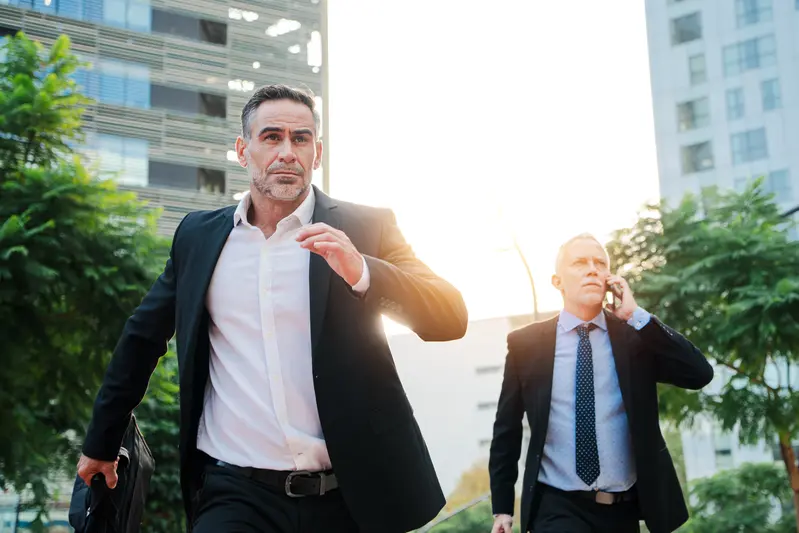VIP Security Planning: How Event Security Management Safeguards High-Profile Events
Imagine an international tech conference where a Fortune 500 CEO is the keynote speaker. The world is watching, and the venue is packed with industry leaders, media, investors, and eager attendees. Among the things the tech CEO wants to share with the world are AI, the future of innovation, and sustainability – a unique assortment of topics in a current high-voltage political environment.
Considering the current political environment, the security of the CEO is not only a precaution but a necessity. Any disruption, whether from unauthorized access by an overzealous fan or any form of protest, can cause reputational damage, physical harm, or affect the company’s shares in the stock market.
A lot has to be done to plan and coordinate their security. This includes:
- Doing a thorough risk assessment
- Identifying potential vulnerabilities in the venue through scouting
- Coordinating with law enforcement
- Contingency planning
The team offering VIP security also understands the need to portray the tech CEO as approachable and charismatic. So, they are committed to leveraging discrete protection tactics and being as invisible as possible.

As it sounds, VIP security planning is not only complex but also a high-stakes process that requires adaptability, precision, and expertise.
Here’s a step-by-step guide on event security planning in 2025.
Initial Planning Phase: Venue & Risk Assessment
A comprehensive venue scouting process is the first line of defense, allowing security teams to preempt issues before crowds arrive. While event planners and corporate security providers cannot control political temperatures or trends, they can address concerns such as data breaches and enhance threat detection through effective risk management strategies to ensure a peaceful and safe event.
These include:
Venue Selection and Layout
Where an event is held makes all the difference. So, event organizers should opt for venues with built-in security features such as CCTV coverage and secure entrances for emergencies.
Additionally, a team offering event security services should conduct thorough site visits before the planned event. Among the concerns they should prioritize are evaluating blind spots and emergency routes. Checking vantage points is also key for public appearance security. Implementing effective safety protocols, robust security solutions, and comprehensive emergency plans helps prevent security incidents and ensures a safe environment for all attendees.
Venue Risk Assessment and Threat Analysis
The next step is analyzing potential threats using intelligence tools and open-source intelligence (OSINT). These threats can range from local crime rates and political unrest to protest activities, all of which can vary depending on the event type, venue capacity, and meeting objectives.
After assessing all potential threats and safety hazards, a team offering VIP security can develop better crowd management strategies. This includes screening attendees, adjusting staffing to meet the minimum requirements, deploying advanced technology, and planning for worst-case scenarios.
Collaborating with Venue Management
Even though risk assessments and site visits help address most security vulnerabilities when protecting VIPs, there is a need to involve the venue’s existing security protocols and security practices. Venue staff can offer valuable considerations and insights on fire exits, blind spots, and other emergency routes, which are critical in any security situation.
Integrating executive protection with the venue’s existing human resources, such as in-house medical staff, further ensures that in case of emergencies, VIPs are safe. This partnership also addresses key security concerns and enhances overall efforts by streamlining resources. Planning a security detail from scratch can be costly and time-consuming, which may not be feasible for most high-profile events.
Local Law Enforcement Coordination for High-Profile Event Protocols
Local authorities are important allies. Their familiarity with the area and real-time information about potential disruptions can be game-changers for safe event execution. This is a strategic move, not just a checkbox, whether a corporate summit, a political fundraiser, or a high-profile product launch.
How helpful are local law enforcement to security teams? They offer boots-on-the-ground intel, which even the most advanced GPS cannot provide. They know planned protests, sketchy hotspots, traffic patterns, and any other information any VIP security team may need for better protection.
The coordination between the executive protection team and the local police starts with setting up real-time communications. They can share radio frequencies and encrypted messaging apps or leverage old technology like walkie-talkies. Police must also be updated on VIP arrival times, potential choke points where crowds may gather, and convoy routes.
The partnership also means getting the paperwork right. Executive protection teams must get permits for road closures and sidewalk barricades and provide traffic diversion plans for approval. These permits should be filed on time with local security agencies.
The bottom line? A good EP (Executive Protection) plan should never exist in a vacuum but should tap into local partnerships to ensure smooth operations and avoid logistical nightmares.
Close Protection Tactics & Crowd Management Strategies
While large crowds can be unpredictable, structured crowd management and discreet close-protection tactics ensure that even high-profile individuals can move freely and safely.
Here are some strategies to ensure the event stays on track and high-profile individuals remain safe.
Crowd control
Large crowds are the ultimate wildcard; they can be electric and unpredictable. That is why every EP team must have a strong strategy for managing crowds.
The first step to keeping everything organized is to place barriers. Event organizers and security teams should leverage stanchions, barricades, and rope lines. While many organizers treat them as mere decorations, they are ideal tools to create buffer zones, blocking off VIP access points and controlling the flow of attendees.
Crowd control should also incorporate queuing systems and checkpoints. Queues paired with security points, such as bag checks, metal detectors, and now AI threat scanners, have proven effective at keeping threats out and maintaining order.

What about the worst-case scenario? That is why a good crowd control strategy should include emergency options such as multiple exit routes and a well-thought-out medical plan.
Conference Security for Executives
Close protection is no longer about bodyguards with earpieces but a combination of different strategies. One of them is sending a shadow team to the venue. Their goal is to coordinate with staff, stress-test communication systems, and map secure routes such as elevators, back hallways, and service entrances.
On the event day, they should provide discreet protection, as the best security blends in seamlessly. The average attendee should not know the difference between the security team and other service providers, such as photographers and event staff.
Since predictability is a liability, the EP team should find the safest and best way to arrive and leave. They can find innovative ways of being unpredictable, such as coming through the lobby and leaving via the loading dock, using decoy motorcades, or using different vehicles.
Scenario Training & Mock Drills
Security teams should operate on the mantra that they cannot prepare for every scenario but can drill for the worst. As part of crowd management strategies to keep high-profile individuals safe, they should regularly conduct drills.
Teams should occasionally run simulations such as fake protests, staged crowd surges, and medical emergencies to stress-test protocols. With these drills, staff and VIPs can respond more effectively during actual emergencies and follow evacuation routes with confidence.
Security Perimeter and On-Site Operational Coordination
A well-orchestrated command center acts as the event’s nervous system, relaying critical information instantly and coordinating swift responses to any security alerts.
Let’s break down the playbook for keeping thousands of people safe and VIPs even safer.
Set up a Command Center
A command center is not a reactive panic room but a space for real-time, proactive decision-making. It should be crammed with instant communications to the on-ground team, live camera feeds, and a direct line to law enforcement.
Security teams should also consider integrating AI-driven tech to flag anomalies such as a lone bag lingering too long. Thanks to having real-time intel, the security team can spot even a minor brewing scuffle in any part of a venue before it escalates.
Issue Credentials to Keep Gatecrashers Out
For an event to be safe and run smoothly, organizers and security teams should issue badges, RFID passes, or biometric scanners to VIP guests, staff, and media.
The passes act as digital bouncers for restricted areas. For example, while still having access to the event venue, some staff may be restricted to places such as tech grids, not charcuterie tables or green rooms.
The centralized system should also be able to cross-reference faces and credentials in milliseconds. If a person is in an area they are not supposed to be in, security should get an alert before escorting them.
Have a Unified Communication Protocol
All security staff, event managers, and law enforcement teams should be on the same page. This means all team members operating on shared radio channels or secure apps, allowing information to flow and changes to be made faster.
In addition to relying on technology, there should be small briefings every few hours. During those bite-sized meetings, teams should sync on various issues, such as weather threats and crowd shifts. As a result, organizers can successfully turn fragmented teams into a single well-run machine.
Contingency Planning & Emergency Response
Whether a minor medical issue or a critical security threat, contingency planning ensures a swift, controlled response, protecting both the principal and the event’s reputation.
A bulletproof contingency plan should include the following elements:
On-Site Medical and Evacuation Plans
In case of anything, VIP emergency protocol should be seamless. Forget the dusty first-aid kit under the desk; modern medical preparation means ensuring on-site paramedics and pre-negotiating response times with local hospitals.
Medical emergencies also mean thinking ahead and mapping out how to handle anything from dehydration by including hydration stations to crowd crush injuries.
Protest & Civil Unrest
Evasion beats confrontation. Planners should have pre-designated evacuation routes and secure, safe rooms. These spaces should be stocked with water, Wi-Fi, and any other essentials as security teams call in reinforcements. So, informing and working with security agencies before the event should be prioritized.
Active Threat Situations
Speed wins, and a 60-second head start could mean keeping VIPs safe and leaving a venue safely. Event organizers and EP teams should, therefore, train their staff on faster ways of sealing venues, maintaining real-time communication with police, and herding attendees to hardened safe rooms.
The best way to ensure a team responds faster in emergencies is by regularly running drills until the team can do these emergency responses blindfolded.
Crisis Communication
Silence is the enemy when chaos strikes, especially in the age of social media, where rumors spread fast. Organizers should partner with PR firms and craft clear and immediate statements. They should ensure consistent messaging to not only mitigate panic and rumors but also to set the record straight.
Proactiveness in communication not only gives organizers control over the narrative but also restores attendees’ confidence. The goal is to ensure people attend future events, whether a road tour for a musician, a festival, or the now-popular podcast recording tours.
Behind the Scenes: How High-Stakes Events Avoid Disaster
While there have been instances where EP teams and security organizers were caught unprepared, there are also many success stories. Despite challenges, security teams were able to pull off a flawless event.
Here are three recent examples.
Case Study 1: Tech Summit in a Politically Volatile City
The CEO of a renowned tech company was set to keynote a conference, but the host city was simmering with activism. Threats of disruption were looming due to a range of issues, including the company’s slow adoption of sustainability practices in its manufacturing.
The organizers teamed up with local law enforcement for crowd control. They also deployed low-profile security and planned a decoy route for the CEO. Even though protest zones were only blocks away and there were visible tensions, the event was successful.
Case Study 2: Celebrity Jet-In at a Music Festival
A Grammy-winning artist made a surprise appearance at a festival. He recently dropped an album with almost all the songs charting on the Billboard 100. The crowds were hyped, but knowing how unpredictable festival crowds can be, the organizers had to make some changes.
First, they rolled out tiered barricades and sent an advance team to scout the stage to be sure it was safe for the artist. There was also real-time communication between the artist’s security and festival staff.
Thanks to better planning and ensuring staff members were on board, the celebrity performed and left early. Aside from the terrible cell service, the crowd was happy and entertained.
Case Study 3: Corporate Product Launch
A tech company recently unveiled a gadget they had teased for years at WWDC. Before the unveiling, there were rumors about competitors not only crashing the big event but also leaking the gadget’s specs before people could pre-order them.
The company issued RFID badges to all tech influencers, journalists, and other attendees with more security layers, such as venue access and real-time tracking. The security team also monitored social media feeds for suspicious leaks or hashtags.
Results? The product launch went smoothly, and most tech YouTubers posted positive reaction videos — a win for the company.
Post-Event Debrief & Continuous Improvement
Effective security planning doesn’t end when the event concludes—it’s an ongoing learning process that refines procedures for the next appearance. The best security plans are not static, but they are living and breathing systems that need to evolve.
Here is a guide on ensuring mistakes are turned into learning experiences and missed chances into solid security plans in the future.
Post-Event Analysis
Event organizers should gather security teams, event staff, and local authorities for a debrief. They should note what their team says about the event and what went wrong. For example, a communication glitch, an issue with entry points, or any other issue that prevented them from delivering a nearly perfect event.
Data Gathering & Reporting
Event organizers and their teams should also review incident logs, video footage, and crowd flow analytics to gain a detailed understanding of past events. Analyzing this data helps identify patterns and requirements essential for improving safety at community gatherings. With this evidence and numbers, it becomes easier to understand what went wrong and develop a more effective security approach to avoid similar issues in the future.

For example, if most incidents happen around the merch tent, event organizers can allocate more manpower to staff selling merchandise in future events.
Strengthening Local Law Enforcement Coordination and Team Relationships
After everything is complete, an event organizer should thank security, law enforcement, medical teams, and venue management. Debriefing over coffee also allows these teams to gel and create good partnerships for future events.
Event Security Planning Mistakes and How to Avoid Them
Even experienced teams sometimes slip on details, like assuming an event schedule will run on time. Building buffers for every scenario is crucial.
The main mistakes organizers and security teams should avoid are:
Underestimating Crowd Psychology
Anything can happen at an event. A headliner can run late, and a surprise protest in a previously relaxed crowd can turn it into a charged mob. Unfortunately, event organizers often forget humans are not robots, and they can be unpredictable.
To fix this, organizers should run crowd simulations for the worst-case scenarios, map emergency exit routes, and ensure their crisis communication team receives real-time updates.
Insufficient Law Enforcement Coordination
While they can still come and help, police do not love last-minute calls, especially when crowds at an event have become unmanageable. If possible, event organizers should start involving police and local authorities months before the event.
Ignoring the Digital Wild West
If there is something hackers love, it’s high-profile events. So, neglecting cyber threats undermines the effort put into ensuring the event infrastructure runs smoothly.
Organizers should run cybersecurity audits on all tech, hire social media experts to monitor threats, and prepare a crisis strategy to reclaim the narrative if it is a big event.
Lack of Plan B
Regardless of how good an event plan or a VIP protection system is, not having a plan B is a recipe for chaos. The chaos can be in the form of weather, transit strikes, or potential threats from the public.
By having a plan B, organizers build buffers into timelines and ensure everybody is safe, regardless of the emergency.
Conclusion
A successful high-profile event results from careful planning, coordination with authorities, and solid contingency plans. Knowing that people can be unpredictable also keeps staff on high alert and ensures there is a buffer between VIPs and the danger in case of any emergencies. This makes the difference between a PR nightmare and a memorable event for attendees.
What are the main takeaways? Planning for chaos (not perfection), collaborating with authorities, and knowing that the crowd’s mood is your responsibility are some of the best secrets to a successful event. You should also ensure that your security provider maintains open communication with both the crowd and your team.
Ready to Level Up Your Event Security?
Why stress about keeping your VIPs safe when you can outsource to experts? Our Executive Protection & Event Security team helps people like you plan for the “what ifs” and ensure everything runs smoothly. We offer protection to CEOs delivering high-stakes keynotes and VIPs attending events.
Click here to explore our services. Or better yet, schedule a risk assessment for your next event.




